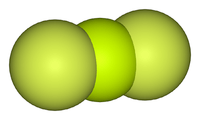Linear molecular geometry

Idealised structure of a compound with linear geometry.

Structure of beryllium fluoride, a compound with a linear geometry.
In chemistry, the Linear molecular geometry describes the arrangement of three or more atoms placed at an expected bond angle of 180°. Linear organic molecules, e.g. acetylene, are often described by invoking sp orbital hybridization for the carbon centers. Many linear molecules exist, prominent examples include CO2, HCN, and xenon difluoride. Linear anions include N3− and SCN−. Linear cations include NO2+.[1]
See also
References
- ↑ Greenwood, N. N.; & Earnshaw, A. (1997). Chemistry of the Elements (2nd Edn.), Oxford:Butterworth-Heinemann. ISBN 0-7506-3365-4.
External links
- Chem| Chemistry, Structures, and 3D Molecules
- Indiana University Molecular Structure Center
- Interactive molecular examples for point groups
- Molecular Modeling
- Animated Trigonal Planar Visual
| ||||||||||||||||||||||||||||||||||